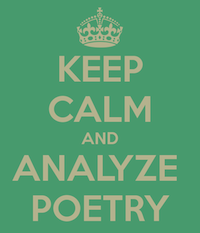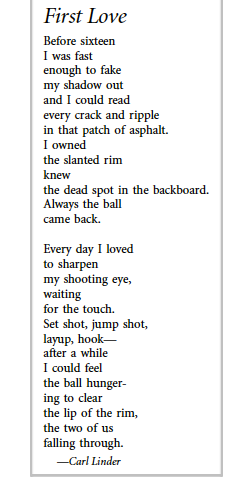Making Room for Poetry in Standards-Based Classes
by Gwen Flaskamp
Take a minute to reflect: how often do you share poetry with students? Do you read aloud a poem daily? Weekly? Monthly? Never?
Recently, Stephanie Harvey, author of The Comprehension Tool Kit, tweeted her view:
“Every child every day should hear an adult read something aloud, equal amounts of fiction and nonfiction and at least one poem a day” (@Stephharvey49).
While most state standards emphasize the importance of exposing students to informational text as well as literature, the reality is that many classrooms are choosing to replace quality poetry with informational text. Informational texts must be taught alongside quality poetry and not in lieu of it. Here’s why:
1. Poetry Plays a Pivotal Role in Common Core Expectations
Poetry remains an important genre in the middle grades. The seventh grade Common Core literature targets alone make multiple references to poetry. Standard Four reads:
Determine the meaning of words and phrases as they are used in a text, including figurative and connotative meanings; analyze the impact of rhymes and other repetitions of sounds (e.g., alliteration) on a specific verse or stanza of a poem or section of a story or drama. And Standard Five: Analyze how a drama’s or poem’s form or structure (e.g., soliloquy, sonnet) contributes to its meaning.
The sophistication of these standards is evident, as is the importance of continuity in learning. Poetry instruction obviously cannot begin and end with seventh grade. Students must start exploring poetry in kindergarten if seventh graders are going to be able to master these rigorous standards.
Should teachers everywhere, then, dust the cobwebs off of our six-week poetry units and devote weeks to the identification of figurative language? Thankfully, no. While we as teachers may mourn the death of this traditional unit, it is quite possible that the only day of that unit not entirely lost on most boys was the day when they could bring their favorite rap lyrics to school and discover — yet again — that music is poetry.
Poetry instruction should be engaging and motivating for all students and needs to go beyond figurative language identification, which is neither a rigorous task nor likely to provide students with the discernment skills necessary to meet the new Common Core expectations.

Instead of a separate poetry unit, poems can be embedded within every unit, connecting them to readings about history, science, and the humanities. This calls for some cross-curricular conversations, but isn’t that what the Core anticipates?
2. Poetry Increases Students’ Knowledge of Words & Language
Research solidly supports that explicit instruction of words increases a student’s ability to comprehend challenging text — a necessary precursor to the Common Core Targets that require synthesis and analysis of these same texts.
When middle students struggle with comprehension, their struggle is often due to the many vocabulary words they do not know. What better way to motivate kids to learn new words and use them playfully than through poetry?
Poets have been known to contemplate a single word change in a line for days or weeks, aware that the subtle changes in sound and meaning of the new word can enormously impact the whole. How great would it be if our students could channel a bit of this passion for words through the exploration of mentor texts?
3. Poetry Increases Students’ Ability to Engage in Authentic Discussions
Another common misconception of the Common Core Standards is that text dependent questioning is the only type of questioning that is worthwhile. Although the Core requires students to dig deep into the text when participating in class discussions, we would be doing a serious disservice if all discussions were entirely scripted and teacher-centered, following the format of many existing close-reading exemplar units.

We must continue to engage students in multi-layered discussions of these types because they serve as a pathway to self-identification. Text dependent questioning followed by reader-response questioning will lead to authentic discourse in classrooms and create life-long readers of our students.
Poetry is the perfect medium to help students engage in authentic discourse and make connections to real-world events. What could be more powerful than reading a poem from a hurricane survivor after learning about the science behind the disaster? What has a more lasting effect on the human heart than reading a poem written by a Holocaust survivor after we have studied this horrific tragedy in a history class?
According to Aristotle, “Poetry is finer and more philosophical than history; for poetry expresses the universal, and history only the particular.” Why not make the particular more accessible and significant in the minds of our students by supplementing it with poetry?
4. Poetry Provides A Bridge To Social Emotional Learning
Poetry is about emotional discovery and understanding the world. It helps us cope when times are tough and celebrate when life is joyous.

Social Emotional Learning requires students to view events from the perspectives of others, valuing the differences in attitudes that make us individuals. Poetry is the perfect medium to help students grow in this area.
For more “hard” and “fast” proof that poetry increases empathy in students, consider a recent research study by The New School. Students given literary fiction reading assignments scored significantly higher in their ability to recognize and draw conclusions about the feelings and emotions of others, compared to students who were given non-fiction or genre-fiction reading assignments. The results of this study speak volumes about the need for students to be exposed to quality literature, including poetry, to better understand the world.
So Poetry Matters: Now What?

Whether you choose to use Atwell’s book or other sources to expose your students to poetry doesn’t matter. What does matter is that we educators band together to make sure poetry does not become the forgotten stepchild of the literary family and the contemporary classroom.
Gwen Flaskamp is a reading interventionist and literacy coach in an Illinois middle school implementing the Common Core. Gwen is also a writer, poet, reader and the mother “of two amazing boys.” She blogs at Gwerica on Literacy (with Erica Martin) and tweets @GwenFlaskamp.
[Credit: “First Love” by Carl Linder is the focus of one of Nancie Atwell’s lessons]



































